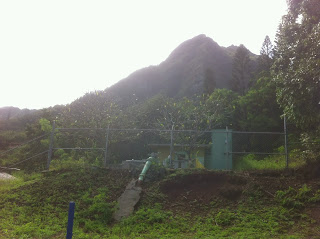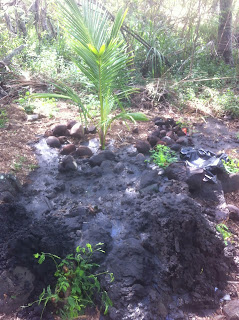Ann Marie Kirk's short film, "Short Kine Stories" contained an interview with a Waimanalo man with a peculiar stone now located near his porch. It got my mind jumbling about stories I have read concerning important ancient fishing shrines of the district. During the question and answer portion of the Oiwi film showing that night, I asked Ann Marie where that stone exactly was. Because I was planning a trip to Waimanalo the next day with my wife, to look for plant nurseries. She said it was at a home in Kalapueo, above the Honu fishpond at the end of Waimanalo.
Kalapueo is what remains of an old fishing village. I didn't get a chance to talk to anyone outside of their homes but it still has the feel of old Hawaii, as I would have imagined it. There was even a canoe being carved and some people cooking outside, sitting on woven hala mats.
Here is the stone that was the topic of one of the stories in the movie. I forgot the homeowners name, but he basically mentioned how a woman approached him about fifteen or so years before the interview. She asked him to take care of a stone that was somewhere in the area. He could tell it must have been important to her and the whole idea of Hawaiian culture. So he agreed to care for it. He took his truck and went to collect the stone from wherever it was, and set it outside of his house. This was not an easy task as the stone is just a little smaller than a La-Z-Boy recliner and it must have been pretty heavy. He mentioned in the film that he could tell it was somehow related to fishing because the curve on the top was most likely used to hold the fish while it was being cleaned.
I know of two particular stones that were said to have been from this district. The first is Malei, it stood on the back of Makapuu hill on the Koolau side. It is site #1 in McAllisters island wide survey. He mentioned that it was above the lighthouse and was a female kupua. It was given burnt offerings and sung to. Charles Alona, the informant of Waimanalo Oahu place names, mentioned that it also was offered Uhu fish and attracted abundance of fish all of the way to Hanauma Bay. Another mentions Lipoa seaweed leis being left by the alii and how the stone actually came from Molokai. Aiai son of Ku'ula brought it there to be set up as a fish god. A chant about Hiiaka mentions Malei and Moeau Point (Makapuu Point).
Sometime later John Cummings is said to have taken malei to his home in Waimanalo until his death and then the stone was taken back to Makapuu Point. Other stories mention that it was taken to Bishop Museum, that it was buried somewhere near Makapuu, or that it was pushed into the ocean. Some stories mention it causing sickness and death to those that disturbed it. Now it is lost to history...
Another famous stone to Waimanalo folklore is that of Kini. It was also a fish shrine and female kapua that was said to help attract akule and O'io. It had a slight depression on its top that fishermen used to pour awa on it before going out to catch fish. The first fish caught was left on the stone as an offering of thanks and the last kanaka t have left an akule on it was a Maui man, Kaalele. Later during road construction and widening. The stone was tossed on the mauka side of the road and left on it's side. The informant Charles Alona mentioned how he hoped that the stone sould be set somewhere that it could see the ocean...
Could the stone now sitting outside of that Waimanalo home possibly be one of these famous pohaku? This is the view that is now has. In the movie that home owner mentions that he never saw that woman that asked him to care for the stone ever again. All must be right with the land and sea, in this time and district then...
Sad to say but I didn't find anything else of immediate historic cultural significance to share with you. As far as my research so far reveals. I did get a better feel of the land and will try to return and take a closer look at places that I now know exist deep in the valleys down empty dirt roads. Most likely in tights and on my bike. Since that never looks threatening when trespassing...
The following images are glimpses of what we found at the end the valleys from Waimanalo to Waiahole.

























